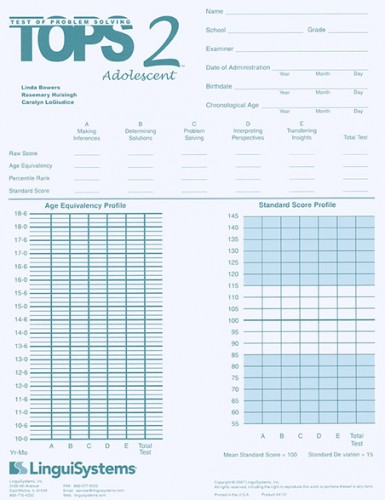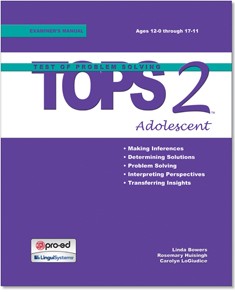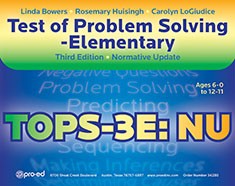Test of Problem Solving 2: Adolescent (TOPS-2:A)
- Ages 12 to 17
- Grades 7 - 12
- Testing Time 40 minutes
-
Product Code 34130 ( MR #059002 )
* Qualifications required to purchase this item. Click here to complete the qualifications form.
Price $213.00
Contents
-

Test of Problem Solving 2: Adolescent (TOPS-2:A)
TOPS-2:Adolescent Examiner's Manual
Second Edition
*Not available separately (package component only)
-

Test of Problem Solving 2: Adolescent (TOPS-2:A)
TOPS-2:Adolescent Reading Passages Book
Second Edition
*Not available separately (package component only)
-

Test of Problem Solving 2: Adolescent (TOPS-2:A)
TOPS-2:Adolescent Test Forms (20)
Second Edition
$54.00
- understanding/comprehension
- analysis
- interpretation
- self-regulation
- evaluation
- explanation
- inference
- insight
- decision-making
- intent/purpose
- problem solving
- acknowledgment
- Subtest A: Making Inferences
The student is asked to give a logical explanation about a situation, combining what he knows or can see with previous experience/background information. Students who do well on this subtest make plausible inferences, predictions, or interpretations.
- Subtest B: Determining Solutions
The student is asked to provide a logical solution for some aspect of a situation presented in a passage.
- Subtest C: Problem Solving
This subtest requires a student to recognize the problem, think of alternative solutions, evaluate the options, and state an appropriate solution for a given situation. It also includes stating how to avoid specific problems.
- Subtest D: Interpreting Perspectives
A student who does well on this subtest will evaluate other points of view in order to make a conclusion.
- Subtest E: Transferring Insights
The student is asked to compare analogous situations by using information stated in the passage.
- Copyright 2007

 Proud to be Canadian
Proud to be Canadian

